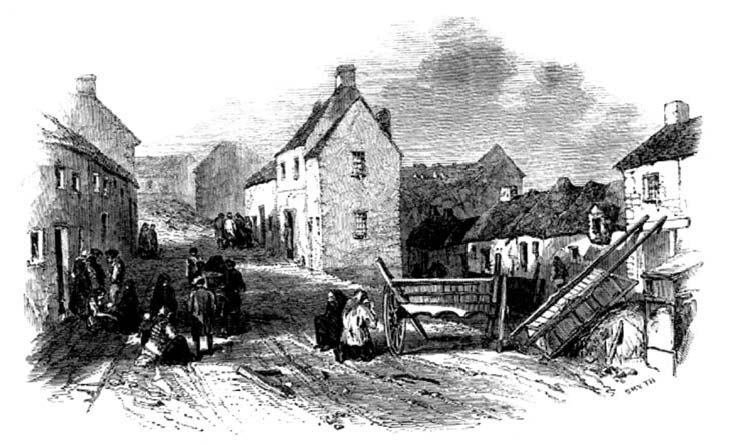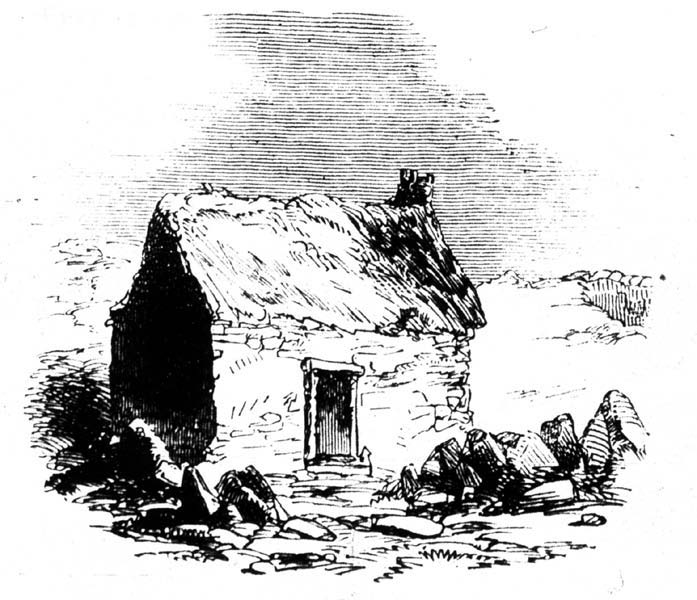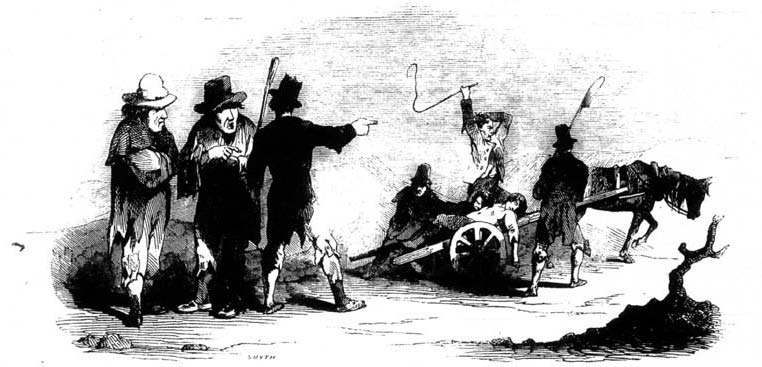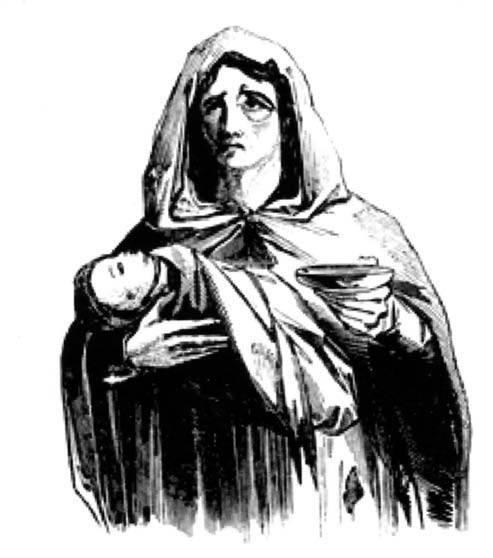II – A Shocking Account
The scepticism on the part of some politicians about the extent of the problem in Ireland proved extremely costly for the country, and the high price paid by the unfortunate people can neither be ignored nor forgotten.
In 1847, the Illustrated London News reported that accounts from the Irish provincial papers continued to detail the terrible sufferings of the starving peasantry in Ireland. The artist James Mahoney from Cork, who was working for the Illustrated London News at the time, recounted his experiences in the newspaper. His journey began in Cork city; his destination was Skibbereen. One of the worst hit areas in Ireland during the famine was Skibbereen in County Cork. ‘Remember Skibbereen’ became a byword for rebels in the years following the famine; in fact it is occasionally still uttered today. He encountered few problems during the journey until he reached Clonakilty, where he stopped for breakfast. It was here that the horrors of poverty first became visible to him. Vast numbers of ‘famished poor’ flocked around the coach and began begging. Among them was a woman carrying the corpse of a small child in her arms. She was making the most distressing appeal to the passengers for aid to ‘enable her to purchase a coffin and bury her dear little baby’. Upon enquiring at the hotel, Mahoney was informed that each new day brought ‘dozens’ more destitute and starving people to the town.[1]
Upon leaving Clonakilty, Mahoney encountered yet more evidence of misery. He recorded meeting a funeral party almost every hundred yards. This continued until he reached an area close to the Shepperton Lakes. Here, the distress became even more striking. When he reached Skibbereen, he stayed at the residence of Mr J. McCarthy-Dowling. It was while at this location that he met with Dr D. Donovan and his assistant, Mr Crowley. Dr Donovan had been recording the devastation caused by the famine in his diary. He was also publishing extracts from the diary in the Cork Southern Reporter, yet people remained doubtful that such devastation in the countryside could be true. Accompanied by these two men, Mahoney visited areas around Skibbereen. He recorded that ‘neither pen nor pencil could ever portray the misery and horror, at this moment,
to be witnessed in Skibbereen’. Dr Donovan then accompanied Mahoney to Bridgetown where, upon arrival, they witnessed even worse sights. On visiting one particular house Mahoney noted that the dying, the living and the dead were indiscriminately lying close to each other with nothing to protect themselves, save a few miserable rags that served as clothing. Some of the dead remained scattered amongst the living for up to six days at a time; such was the level of weakness and fear of disease that family members delayed so long in burying their loved ones. These scenes were commonplace; all the houses contained similar horrors. No family was spared. Of some five hundred houses, not one was free from death or fever.

Old Chapel Lane, Skibbereen, County Cork.
(The Illustrated London News, 13-2-1847)
Mahoney and Dr Donovan proceeded to High Street or Old Chapel Lane where they came upon a house with neither doors nor windows. It was filled with destitute people lying on the bare floor. Amongst them was the body of a ‘fine, tall, stout country lad’, who had sought shelter from the piercing cold. The witnesses felt sure that the other occupants of the house would soon join him in death. It was a heart-rending sight and Mahoney and the other members of their group instinctively wanted to help alleviate the dreadful situation. But Dr Donovan became alarmed that they would put themselves at risk of infection and he pleaded with them not to enter the house and to avoid physical contact with the people gathered in the doorway.[2]Their next stop was at the Chapel yard. The following extract, taken from the diary of Dr Donovan, describes what they encountered:
On my return home, I remembered that I had yet a visit to pay; having in the morning received a ticket to see six members of one family, named Barrett, who had been turned out of the cabin in which they lodged, in the neighbourhood of Old Chapel yard; and who had struggled to this burying-ground, and literally entombed themselves in a small watch-house that was built for the shelter of those who were engaged in guarding against exhumation by the doctors, when more respect was paid to the dead than is at present the case. This shed is exactly seven feet long, by about six in breadth. By the side of the western wall is a long, newly made grave; by either gable are two of shorter dimensions, which have been recently tenanted; and near the hole that serves as a doorway is the last resting-place of two or three children; in fact, this hut is surrounded by a rampart of human bones, which have accumulated to such a height that the threshold, which was originally on a level with the ground, is now two feet beneath it. In this horrible den, in the midst of a mass of human putrefaction, six individuals, males and females, labouring under most malignant fever, were huddled together, as closely as were the dead in the graves around.
At the time (eleven o’clock at night) that I went to visit these poor sufferers, it was blowing a perfect hurricane, and such groans of roaring wind and rain I never remember to have heard. I was accompanied by my assistant, Crowley, and we took with us some bread, tea and sugar; on reaching this vault, I thrust my head through the hole of [the] entrance, and had immediately to draw back, so intolerable was the effluvium; and, though rendered callous by a companionship for many years with disease and death, yet I was completely unnerved at the humble scene of suffering and misery that was presented to my view; six fellow creatures were almost buried alive in this filthy sepulchre. When they heard my voice, one called out, ‘Is that the Priest?’ another, ‘Is that the Doctor?’ The mother of the family begged in the most earnest manner that I would have them removed, or else that they would rot together; and they all implored that we would give them drink. Mr Crowley produced the tea and sugar, but they said it was of no use to them, as they had no fire or place to light it in, and that what they wanted was water; that they had put a jug under the droppings from the roof, but would not have drink enough for the night. The next day I got the consent of the Poor Law Guardians to have my patients removed from this abode of the dead to the fever hospital, and they are since improving.[3]

Tim Harrington’s hut, County Cork.
(The Illustrated London News, 13-2-1847)
James Mahoney proceeded to enlist the help of a Mr Everett, who had a great knowledge of the countryside. During their journey they visited a hut where four people had lain dead for six days; it was the abode of a Tim Harrington. On hearing their voices, Mr Harrington made an effort to reach the door, and he asked for a drink of water and a fire to keep him warm. He collapsed in the doorway and in all probability died as they were unable to give him aid through fear of contracting disease. Mahoney and Everett continued on to Schull where they encountered a group of over three hundred women looking to purchase food. Some had queued from daybreak to buy Indian meal from government-appointed officers. The officers appeared to be issuing ‘miserable quantities’ at high ‘famine prices’. Mahoney’s harrowing reports were published in their entirety in the Irish newspapers as well as the Illustrated London News, and should rightly have inspired an urgent response from the government.[4]

Funeral at Skibbereen, County Cork.
(The Illustrated London News, 13-2-1847)
Another two men to publish reports on the de-vastating effects of the famine were Mr Forster and his son from Leeds. They visited Connacht in January 1847 on behalf of their community, to view ‘first-hand’ the devastation caused by the famine. The following is an extract taken from their report on the village of Bunderagh in Connemara:
One poor woman, whose cabin I had visited, said, ‘There will be nothing for us but to lie down and die.’ I tried to give her hope of English aid, but, alas, her prophecy has been too true. Out of a population of 240, I found 13 already dead from want. The survivors were like walking skeletons – the men gaunt and haggard, stamped with the livid mark of hunger – the children crying with pain – the women in some of the cabins too weak to stand.

Woman begging at Clonakilty, County Cork.
(The Illustrated London News, 13-2-1847)
On the way to Clifden, Foster and his son came across around one hundred men engaged in famine-relief road works near Kylemore. Many of them had to walk between five and seven miles every day and earned a mere four shillings and sixpence per week. They had only one meagre meal a day to sustain them during this ‘back-breaking’ stonework. A policeman who was standing close by told the visitors that some of the men work ‘till they fall over their tools’ such was their weakened state.
Upon arriving in Clifden they were confronted with further harrowing sights close to where they were staying. A woman who had crawled into an outhouse on the previous night had died. By the time her body was found, part of her remains had been devoured by dogs. That same evening they observed another corpse being pushed through the streets in a wheelbarrow by a man desperately seeking assistance in burying the body. The following morning Foster and his son left for Galway. Along the way they encountered emaciated women and children, who were almost naked despite the brutal winter conditions.

Funeral at Shepperton Lakes, County Cork.
(The Illustrated London News, 13-2-1847)
As they journeyed throughout Connemara, the question on their minds was not how these people died but rather how they lived. They had anticipated that the situation in Connacht would be bad but nothing could have prepared them for the absolute desolation that greeted them, a desolation that ‘defied all exaggeration’.[5]
One can see from these reports why the coffin ships might have seemed an attractive option, even a salvation, despite the terrible stories that surrounded the voyages. There had been emigration before the famine, but not on the scale witnessed during the famine years and the decades that followed. In contrast to previous emigration, when it was largely young men and women who left the country, children and elderly people constituted a large percentage of those who fled during the famine. Many of them had been weakened by fever and starvation long before the voyage.
Passenger companies took advantage of the des-perate situation. They encouraged mass emigration through newspaper advertisements that promised an escape from the horrors sweeping across the land. Many emigrants were packed into the lower decks like ‘slaves in a slave ship’ and confined without light or fresh air during bad weather, making these ships fertile ground for the spread of disease. In the initial stages of the famine, America responded well with aid, but the sudden influx of starving and impoverished emigrants, many of whom were too weak to work, appalled the American authorities. They enforced Passenger Acts which resulted in some ships being turned away from American ports; for these people all hope was lost.[6]
The following poem appeared in the Illustrated London News on 13 February 1847:
Uncoffin’d, unshrouded, his bleak corpse they bore,
From the spot where he died on the Cabin’s wet floor,
To a hole which they dug in the garden close by;
Thus a brother hath died – thus a Christian must lie!
’Twas a horrible end to a harrowing tale,
To chill the strong heart – to strike revelry pale.
No disease o’er this Victim could mastery claim,
’Twas Famine alone marked his skeleton frame!
The bones of his Grandsire and Father too, rest
In the old Abbey-yard, by the holy rites blest;
Their last hours were sooth’d by affections’ fond cares,
Their last sighs were breath’d midst their Friends’ tearful prayers!
Unshriven, untended, this man pass’d away,
Ere Time streak’d one hair of his dark locks with gray,
His requiem the wild wind, and Ilen’s hoarse roar,
As its swollen waves dash on the rock-girded shore.
Notes[1]The Illustrated London News: ‘Famine and Starvation in the County of Cork’ (16-1-1847); ‘Mortality in Skibbereen’ (30-1-1846); Mr James Mahony, ‘Sketches in the West of Ireland’ (13/20-2-1847); ‘The Late Food Riots in Ireland’ (7-11-1846); ‘The Potato Disease’ (18-10-1845).
[2]The Illustrated London News: ‘Famine and Starvation in the County of Cork’ (16-1-1847); ‘Mortality in Skibbereen’ (30-1-1846); Mr James Mahony, ‘Sketches in the West of Ireland’ (13/20-2-1847).
[3]The Illustrated London News: ‘Famine and Starvation in the County of Cork’ (16-1-1847); ‘Mortality in Skibbereen’ (30-1-1846); Mr James Mahony, ‘Sketches in the West of Ireland’ (13/20-2-1847).
[4]The Illustrated London News: ‘Famine and Starvation in the County of Cork’ (16-1-1847); ‘Mortality in Skibbereen’ (30-1-1846); Mr James Mahony, ‘Sketches in the West of Ireland’ (13/20-2-1847).
[5] Litton, Helen, The Irish Famine: An Illustrated History (1994), pp. 104, 105, 108.
[6]The Galway Mercury: ‘A Famine Report’ (13-3-1847).
The Illustrated London News: A Poem (13-2-1847).